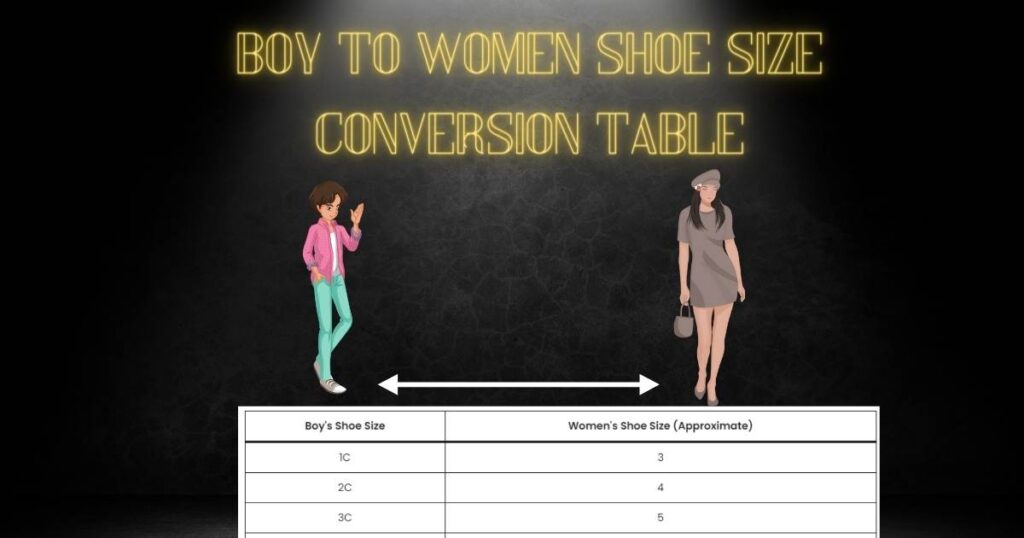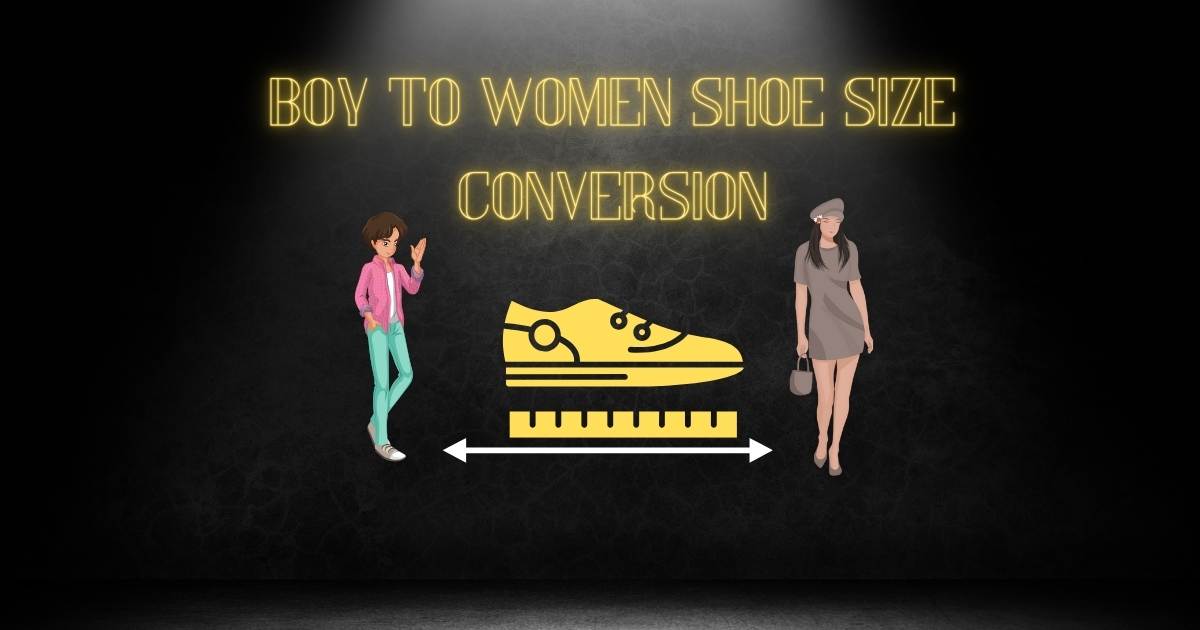Boy-to-women shoe size conversion can be done by subtracting the boy’s shoe size by 2. For example, if a boy wears a size 6, he would wear a women’s size 4. Finding the right shoe size is important for both comfort and style. If you are a boy looking for women’s shoes, it is essential to understand the conversion process. By subtracting 2 from your current shoe size, you can determine your equivalent in women’s shoes. For instance, if you wear a size 6 in men’s or boy’s shoes, your corresponding size in women’s shoes would be a size 4. This conversion ensures that you can confidently shop for the right shoe size and enjoy a comfortable fit.
Boy to Women Shoe Size Conversion Table

When transitioning from boys to women’s shoe sizes, it’s crucial to have a reliable reference for conversion. The table below provides an easy-to-use guide, showing the approximate women’s shoe size for each boy’s size. The conversion is achieved by subtracting 2 from the boys’ size, making it a straightforward process for a quick and accurate fit.
| Boy’s Shoe Size | Women’s Shoe Size (Approximate) |
|---|---|
| 1C | 3 |
| 2C | 4 |
| 3C | 5 |
| 4C | 6 |
| 5C | 7 |
| 6C | 8 |
| 7C | 9 |
| 8C | 10 |
| 9C | 11 |
| 10C | 12 |
| 11C | 13 |
| 12C | 1 |
| 13C | 2 |
Factors Affecting Shoe Size Conversion
Shoe size conversion from boys to women may vary due to factors such as foot shape, width, and brand sizing discrepancies. These factors should be considered to find the right fit.
Factors Affecting Shoe Size Conversion
When it comes to buying shoes for young boys transitioning into women’s sizes, understanding the factors affecting shoe size conversion becomes crucial. From growth patterns to measurement systems to considerations for different shoe types, each aspect plays a significant role in ensuring a comfortable fit. In this article, we will delve into these factors, providing useful insights to simplify your shoe-shopping experience.
Growth Patterns In Boys Vs. Girls
Boys and girls have distinct growth patterns, resulting in variations in shoe size conversion. Generally, girls experience growth spurts earlier, with their feet reaching their full size by the age of 14 or 15. On the other hand, boys’ feet continue to grow until they are around 16 or 17 years old. The rate of growth also differs, with boys often having a more rapid and uneven growth pattern. These variations emphasize the importance of regularly measuring shoe sizes to ensure an accurate conversion.
Different Shoe Size Measurement Systems
Shoe sizes can differ not only between boys and women but also across different countries and regions. Understanding the various measurement systems is crucial to ensure the correct conversion. The most commonly used measurement systems include the US system, UK system, and European system. In the US system, sizes for boys range from 1C to 13C, while women’s sizes usually start from 4 and go up to 12.5 or higher. The UK system follows a similar pattern, with boys’ sizes ranging from 0.5C to 13C and women’s sizes starting at 2 and going up to 10.5 or higher. The European system uses centimeters as the primary unit of measurement, with boys’ sizes ranging from 16 cm to 48 cm and women’s sizes starting from 35 cm and going up to 49 cm or higher.
Considerations For Different Shoe Types
It’s essential to consider the type of shoe when converting sizes from boys to women. Different shoe styles may have specific size discrepancies that need to be addressed. For instance, athletic shoes typically need more room in the toe area, while dress shoes may have a narrower fit. Sandals and heels also have their unique sizing requirements. To ensure a proper fit, it is recommended to try on different shoe types and brands or refer to size conversion charts provided by reputable shoe manufacturers.
To summarize, several factors affect shoe size conversion from boys to women, including growth patterns, measurement systems, and considerations for different shoe types. Understanding these factors will enable you to make informed decisions when shopping for shoes, ensuring optimal comfort and fit for the transition. Remember to measure regularly and consult size charts for accurate conversions, allowing you to find the perfect pair of shoes with ease.
Methods For Shoe Size Conversion
Converting shoe sizes from boy to woman can be a daunting task, but fear not! With the right methods, you can easily find the perfect fit. In this article, we will explore three effective approaches for shoe size conversion: using shoe size conversion charts, calculating conversion ratios, and taking accurate measurements. Whether you’re a savvy shopper or a concerned parent, these methods will ensure a hassle-free shoe-buying experience.
Using Shoe Size Conversion Charts
Shoe size conversion charts are a go-to tool for anyone in need of seamless conversion. These charts provide a simple reference system to match boy’ sizes with their equivalent women’s sizes. To utilize a conversion chart, follow these steps:
- Locate a reliable shoe size conversion chart, typically available online or in-store.
- Identify the boy’s shoe size and find the corresponding women’s size within the chart.
- Take note of any additional measurements mentioned, such as foot length or width, if applicable.
By using shoe size conversion charts, you can quickly and accurately determine the women’s size that aligns with the boy’s shoe size.
Calculating Conversion Ratios
If you prefer a more precise approach, calculating conversion ratios can be the way to go. This method involves determining the relationships between boys and women’s shoe sizes. Here’s how you can calculate the conversion ratio:
- Select a common shoe size that exists in both boy and women’s sizes, ensuring it’s easily accessible for reference.
- Measure the length of the selected shoe size in both boys and women’s sizes.
- Divide the length of the women’s shoe size by the length of the boy’s shoe size.
- Round the resulting ratio to two decimal places for increased accuracy.
The calculated conversion ratio will provide a baseline for converting boy sizes to women’s sizes, allowing you to determine the precise measurements required.
Taking Measurements For Accurate Conversion
For individuals with unique foot measurements or those seeking the utmost accuracy, taking measurements directly is an excellent option. By acquiring the exact dimensions of the foot, you can convert boy sizes to women’s sizes with unmatched precision. Here’s how to ensure accurate conversion:
- Use a foot measuring device, such as a ruler or tape measure, to measure the length and width of the foot.
- Refer to a size conversion chart or consult a shoe size expert to determine the corresponding women’s size based on the measured foot dimensions.
- Consider the specific shoe style or brand you intend to purchase, as sizing may differ slightly.
Taking accurate measurements guarantees a reliable conversion and helps you find the perfect fitting shoes for ultimate comfort and style.
Frequently Asked Questions
A boy’s size 7 in women’s is usually equivalent to a woman’s size 9.
6. 5 Big Kid shoes are equivalent to a women’s shoe size.
A boy’s foot size is typically smaller than a woman’s. To convert a boy’s foot size to a woman’s, you can add about 1. 5 to 2 sizes. For example, if a boy wears a size 5, it would approximately convert to a women’s size 6.
Conclusion
Understanding the conversion between boys’ and women’s shoe sizes is essential for a seamless shopping experience. By following a reliable shoe size conversion chart, you can find the perfect fit and avoid any discomfort or complications with your footwear. So, next time you shop for shoes, keep in mind the conversion process and ensure a comfortable and stylish fit.


